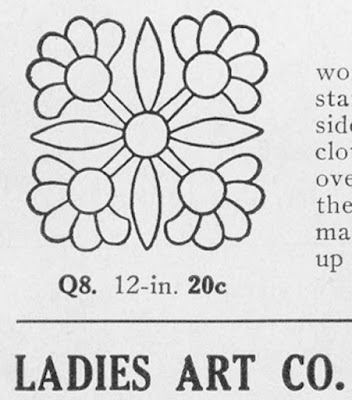Quilt signed
"Jane Barr July 1849"
Collection of the Smithsonian Institution
I don't know what Jane Barr called her pattern, but we'd all agree
it's a Mexican Rose...
A name first published by the Ladies Art Company perhaps in their 1898 catalog
of quilt patterns.
Also published as Mexican Rose by Marie Webster
in her 1915 book Quilts
It's #22.41 in my book Encyclopedia of Applique,
categorized as a four plus four block: Four motifs alternating
with four other motifs rotating from a central point.
The major characteristics are the simplicity of the north/south
units, which can be a diamond or a leaf shape
The corner florals on long stems tend to be multi-petaled and viewed
from the side.
With variation possible
Crib quilt
Lots of extra applique from a mid-19th century quilt from the
Shelburne Museum's collection
From Fourth Corner Antique Quilts
We owe to Webster our connection of the pattern to "stirring frontier activities...Mexican Rose...reflecting domestic interest in important events..." Presumably she is talking of the Mexican War in the late 1840s to gain territory from Mexico.
I'm afraid that Webster's story cannot be substantiated with any evidence that the design was called Mexican Rose in the 1840s when it first appeared or that it had any connection to that war.
In 1906 a writer who saw it as a daisy
wrote a short article about making a sofa pillow
of red, yellow and green silk. The pattern was
copied by several newspapers.
As we can see by Jane Barr's quilt the pattern is decades older.
The example in the Benton County, Oregon, museum
has a border made of the daisies.
Attributed to Mary Ann Myers in Mississippi, documented in
the Texas Project
Once the pattern appeared in print it became popular.
The North Carolina Project found several examples from
the end of the 19th century and perhaps into the 20th.
By Mary Margaret Miller
By M. E. Williams, in
the collection of the North Carolina Museum of History
Colored sashing is typical in this group.
Berks County, Pennsylvania, sampler, late 19th century
The pattern's not often used as a sampler block until after it
was published about 1890. You don't see it in mid-19th-century albums.
The design was also quite fashionable in the Miami Valley
sampler/albums made in Ohio about 1900.
The ELI quilt from the 1890s in the collection
of the International Quilt Study Center and Museum
Like the eagles in this group of quilts, the Mexican Rose variation
was practically a necessity
It's an easy pattern for beginner applique.
Print this out on an 8-1/2" x 11" sheet of paper for a pattern of sorts. It would fit in a 20" finished block.As you can see by all the examples, red and green is probably the traditional fabric choice.



























One of my all time favorite patterns. Especially when the fingers (petals) are nice and long.
ReplyDeleteJane Barr's quilt is my favorite (of the above) because of the placement of the flowers and leaves, each one slightly different. I can almost feel a breeze. What a beauty - signed and dated!
ReplyDeleteRMQM has a nice, 19th cen. Mexican Rose, too!
ReplyDelete